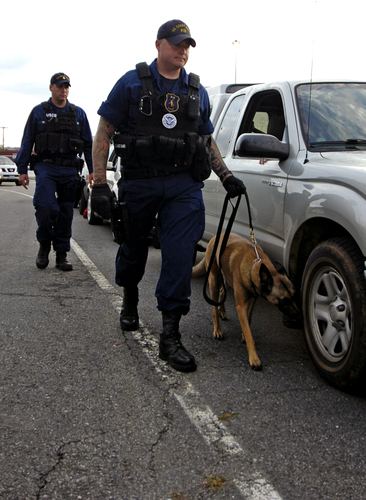 | ||
A Visible Intermodal Prevention and Response team, sometimes Visible Intermodal Protection and Response (VIPR, or VIPER) is a Transportation Security Administration program. Various government sources have differing descriptions of VIPR's exact mission. It is specifically authorized by 6 U.S.C. § 1112 which says that the program is to "augment the security of any mode of transportation at any location within the United States". Authority for the program is under the Secretary of Homeland Security. The program falls under TSA's Office of Law Enforcement/Federal Air Marshal Service. TSA OLE/FAMS shares responsibility for the program with the Office of Security Operations and Transportation Sector Network Management.
Contents
- History
- Purpose
- Components
- Budget
- 2007 Indianapolis bus searches
- DHS Office of Inspector General report 2008
- DHS Office of Inspector General report 2009
- House Appropriations Committee Report 111 157 2009
- Screening of Passengers at Savannah Amtrak Station 2011
- DHS Office of Inspector General report 2012
- References
The VIPR teams detain and search travelers at railroad stations, bus stations, ferries, car tunnels, ports, subways, truck weigh stations, rest areas, and special events. They also can deploy to deal with CBRNE/WMD (chemical, biological, radioactive, nuclear, and explosive weapons of mass destruction). They also inspect ships, containers, and vehicles.
History
The GAO says VIPR was prompted by the 2004 Madrid train bombings. The program started up in December 2005. The program was first created to work in a "non-aviation environment". Bad initial planning caused "strained relations" with local law enforcement. In July 2007 VIPR teams carried out controversial operations in several cities for the holiday weekend (see below). In June 2007 VIPR began working in "aviation environments". In 2007 TSA reported there had been 84 missions in 18 months; as of 2011 TSA was conducting about 8,000 VIPR operations per year. As of 2013 VIPR had an annual budget of $100 million and was growing rapidly.
Notable special events they have worked include the Presidential Inauguration, the Special Olympics, the Democratic National Convention, NFL games and others.
After the 2013 Los Angeles International Airport shooting TSA moved some of its 37 VIPR teams from surface-transportation settings to airports, according to TSA Administrator John Pistole.
Purpose
Different sources provide different statements of purpose for the VIPR teams. Here are a few definitions given by various sources, most of them government officials:
Augmentation
Presence and detection
Terrorism and emergencies
Miscellaneous
Components
Personnel may include the following:
Special tools may include
Budget
FY2009: $30 million, 10 VIPR teams
FY2010: increase of $50 million, for 15 surface transport VIPR teams
FY2012: $109 million
2007 Indianapolis bus searches
In 2007 some Indianapolis bus passengers complained to representative Dan Burton that TSA searches violated their unalienable rights. Burton replied that Al Qaeda was interested in attacking buses and that the Global War on Terror was still on.
DHS Office of Inspector General report (2008)
This report studies problems at VIPR. It "identified concerns regarding chain of command, unclear missions, and insufficient communication". It noted progress, but said those issues were "undermining agency efforts to advance mass transit security".
It especially discussed the controversial VIPR deployments on the weekend of July fourth in 2007. The TSA gave only short notice the local authorities about the VIPR plans, and did not consult them. This disrupted the plans that local authorities had created to deal with holiday traffic. Local transit officials had to work overtime accompanying VIPR teams unfamiliar with local systems such as rail stations; TSA did not reimburse local groups for overtime. TSA also compromised the anonymity, and thus safety, of Air Marshals by requiring them to wear clothing identifying themselves as Federal Air Marshals. VIPR deployments also caused tensions with transit officials and police unions. After these incidents, TSA tried to improve its communication, including setting up a Joint Coordination Center.
The report also mentions a letter in which the National President of the Federal Law Enforcement Officers Association described the VIPR exercises as “clearly a waste of scarce Federal Air Marshal resources."
DHS Office of Inspector General report (2009)
This report focused on the role of Surface Transportation Security Inspectors on VIPR teams. It pointed out that TSI's were "underutilized" and their contribution to the VIPR operations was unclear.
House Appropriations Committee Report 111-157 (2009)
The U.S. Congress House Appropriations Committee wrote a report in September 2009 regarding the U.S. Department of Homeland Security. It included a section on VIPR. It specifically quoted from the two DHS Inspector General reports listed above.
The report also noted that TSA had failed to prepare a report on the "performance standards to measure the success of its VIPR teams in detecting and disrupting terrorism", as it had been directed to by Congress previously. The committee also rejected the TSA's request for more funding for rail inspectors because TSA had failed to hire people to fill its currently allocated inspector positions.
Screening of Passengers at Savannah Amtrak Station (2011)
In early 2011, a TSA VIPR detained and patted down people at an Amtrak station in Savannah, Georgia. The incident became controversial because instead of screening passengers as they boarded trains—the standard procedure—officers were screening passengers as they were getting off trains, presumably after potential terrorists had detonated their explosives. According to Trains magazine, Amtrak Police Chief John O'Connor described the TSA behavior as illegal, in violation of Amtrak policy, and simply nonsensical. The incident led Amtrak to temporarily ban VIPR teams from Amtrak property.
DHS Office of Inspector General report (2012)
Some TSA officials told the auditors that VIPR deployments were not always based on credible intelligence. The auditors said the VIPR teams might not have the required skills and information to do their jobs.
